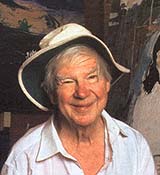
No formal art studies other than a year of night classes at National Gallery Art School, Melbourne.
He learned about art at an early age within the family circle. His father, Merric Boyd, was a potter and sculptor and his mother, Doris Boyd, was a painter and potter. His grandparents, Arthur Merric Boyd and Emma Minnie Boyd, were both landscape painters. His uncle, Penleigh Boyd, was a painter. His brother, David, and sisters Lucy and Mary are painters and his brother, Guy, a potter.
He attended Murrumbeena State School, Victoria. and won many prizes for drawing. At the age of seventeen he went to live with his grandfather who taught him the rudiments of painting in the Heildelberg impressionist tradition.
He held his first one-man show in Melbourne in 1939 and shortly afterwards joined the army where he was to spend three years, mostly in the Field Survey Corps. Here he met John Perceval, later to become his brother-in-law.
After discharge from the army in 1943, he founded a pottery at Murrumbeena with John Perceval and Peter Herbst. He decided to devote all his time to painting and ceramic sculpture in 1949 and at the invitation of Lloyd Rees became involved in the CAS in Melbourne.
During the 1940s his work went through several phases including the painting of a large mural at the home of his uncle, Martin Boyd, at Harkaway near Berwick, Victoria. A series of landscapes of north-west Victoria, a nine metre ceramic sculpture he built in Melbourne for the Olympic Games swimming pool in 1955 and he celebrated his ‘Half-Caste Bride’ series painted 1957-59 after an earlier visit to Central Australia.
A prize winning film was made in Melbourne about his ‘Half-Caste Bride’ series by Tim Burstall and Patrick Ryan in 1959. During the 1960s he lived mostly with his family in London, exhibited widely and established an international reputation including a Romeo and Juliet ceramic Triptych in 1964 to honour Shakespears’s 400 year anniversary.
He returned to Australia during 1971-72 for six months at ANU, Canberra, as a resident Fellow in Creative Arts. In 1975 he presented a large collection of sculptures, etchings and paintings to the ANG Canberra and in 1984 was commissioned to design the tapestry for the reception hall at new Parliament House, Canberra. Worked in UK for part of 1989-90.
Arthur Boyd held many one-man shows in Australia and overseas over the years including Zwemmer Gallery, London; Retrospective shows at Whitechapel Gallery, London 1962; Demarco Gallery, Edinburgh 1969; ANU Canberra 1971-72 and Skinner Gallery Perth 1971; Fischer Fine Art UK 1973,80,83,86; Rudy Komon Gallery 1978,8 Fremantle Arts Centre 1979; Australian Galleries Melb. 1976,81,82,(retro),85,87;Qld. Uni. Art Museum 1982; Hong Kong Arts Centre, Hong Kong 1983;Wagner Gallery 1984,87; AGSA 1984; BMG Adelaide 1984,88; Tokyo and Kyoto, Japan (Wagner Gallery) 1984; von Bertouch, Newcastle 1986,87,89; Works Gallery, Geelong 1985; Solander Canberra 1985; Holdsworth 1985; HPAC 1988; BMG Sydney 1988,89(retro); Wagner Gallery 1989.
Significant group shows include Venice Biennale 1958 and Australian Painters 1964-66 Exhibition (Mertz Collection) Corcoran Gallery; Washington DC USA 1967; ‘Landscape and Image’, Australian Gallery Directors Council Travelling Exhibition to Indonesia 1978; Smithsonian Institute, Washington DC 1985; Commonwealth Institute, London 1988; Venice Biennale 1988; Australian Consulate General, Los Angeles 1987.
Britannica Award 1971; OBE, London UK; Order of Australia(OA) for services to the arts 1979; Australian of the Year 1995.
Receive e-mail updates on our exhibitions, events and more
Subscribe Now